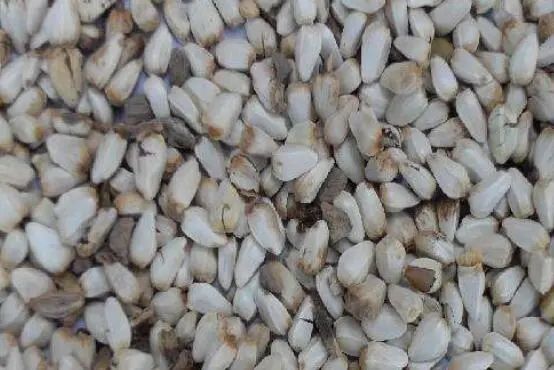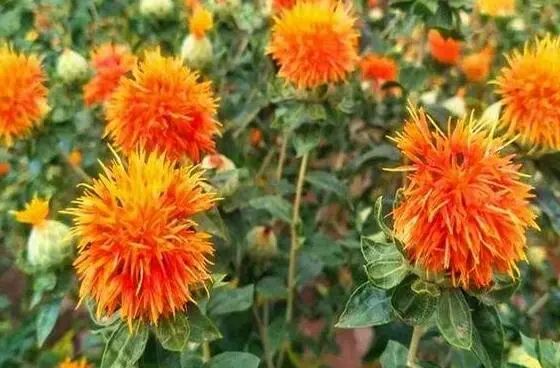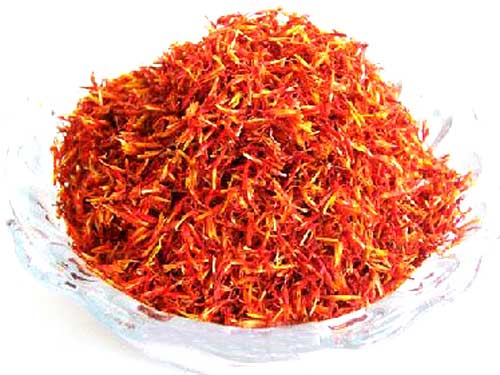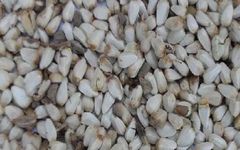————————————————————————————————————————————————————————————————–
Safflower (Honghua) is a common traditional Chinese medicinal herb and a medicinal plant. The flowers of this plant can be used for medicinal purposes, but not much is known about the seeds of safflower (Honghua Ren), which are the mature seeds of the safflower plant. They contain a large amount of unsaturated fatty acids and various minerals, which can provide nutrition to the human body and delay aging. Below is a detailed introduction to its effects and methods of consumption, which will help everyone understand more about safflower seeds.

Effects and Functions of Safflower Seeds
1. Cardiovascular Protection
Safflower seeds contain a large amount of oils, primarily composed of unsaturated fatty acids, especially high in linoleic acid and alpha-linolenic acid. The human body can absorb these substances, which may accelerate the metabolism of fatty acids in the body, reduce blood viscosity, promote blood circulation, and alleviate arterial pressure. They have significant preventive effects on common conditions such as hypertension, hyperlipidemia, and arteriosclerosis.
2. Anti-Aging
Safflower seeds possess strong anti-aging properties. Regular consumption of this ingredient can delay the onset of various aging symptoms due to the presence of flavonoids, vitamin E, and linoleic acid. Once absorbed by the body, these substances can eliminate free radicals and enhance the body’s own antioxidant capacity, preventing the decline of organ functions. Regular consumption can delay aging and promote longevity.

Methods of Consuming Safflower Seeds
1. Cooking Porridge
Safflower seeds can be used to make porridge. To prepare it, you need 150 grams of rice, 10 grams of Dan Shen (Salvia miltiorrhiza), 15 grams of safflower seeds, and 30 grams of sugar. First, slice the Dan Shen, then wash all the ingredients and put them in a pot. Add an appropriate amount of water, bring to a boil over high heat, then simmer on low heat for half an hour. Once the porridge is soft and thick, add the prepared sugar to taste, mix well, and it is ready to drink.
2. Safflower and Black Bean Drink
Safflower seeds and black beans make an ideal pairing. To prepare, place the ingredients in a pot with water, bring to a boil, then reduce to a simmer for 5 minutes. Afterward, continue to simmer until the ingredients are soft, add brown sugar to taste, mash them together, and serve in a bowl. This drink not only tastes good but also has excellent health benefits.
Safflower
Safflower is the tubular flower crown of the Asteraceae plant. It is pungent and warm in nature. It has the functions of invigorating blood circulation, regulating menstruation, and alleviating pain. The decoction of safflower has inhibitory activity against tumor cells, showing effects against mouse sarcoma S180 and leukemia cells. Additionally, it can stimulate the heart, reduce coronary resistance, increase coronary flow, improve myocardial ischemia, dilate blood vessels, lower blood pressure, enhance peripheral microcirculation, inhibit platelet aggregation, and enhance fibrinolysis, as well as lower blood lipids and improve ischemia and hypoxia.
[Dosage] Oral: Decoction, 3-12g.
[Cancer Treatment Efficacy] Commonly used clinically for esophageal cancer, cervical cancer, pancreatic cancer, liver cancer, rectal cancer, acute leukemia, choriocarcinoma, gastric cancer, etc., particularly for those with blood stasis.
1. Esophageal Cancer
① 9g of Tao Ren (Peach Kernel), 9g of Safflower, 15g of Gui Wei (Rehmannia), 15g of Chi Shao (Red Peony), 15g of Su Mu (Sandalwood), 10g of Yu Jin (Curcuma), 30g of Dan Shen, 30g of Zi Cao (Lithospermum), 15g of Jin Yin Hua (Honeysuckle), and 15g of Xia Ku Cao (Selfheal) decocted in water, one dose per day. (From “Integrative Treatment of Cancer”) ② 15g of Safflower, decocted in 200ml of water for long-term use. (From “Practical Anti-Cancer Recipes”)
2. Cervical Cancer
6g each of Safflower and Alum, and 30g of Wu Song (Fritillaria). Decoct, first fumigate, then wash the external genitalia. Once or twice daily, each time for 30-60 minutes. Each dose can be reused for 3-4 days. [Shanghai Journal of Traditional Chinese Medicine, 1984, (9)]
3. Skin Abscesses Caused by Acute Myeloid Leukemia
30g each of Safflower, Frankincense, and Myrrh, 150g of Xiao Luo San (a type of herb), 60g of Gardenia, and 150g of Pearl Grass. Grind into a fine powder, mix with egg white for application or with hot water for dressing the affected area. [New Chinese Medicine, 1977, (4)]
4. Pancreatic Cancer
10g each of Safflower, Tao Ren, San Leng (Sparganium), Chao Wu Ling Zhi (a type of herb), Pu Huang (Typha), Hu Huang Lian (Coptis), Huang Bai (Phellodendron), Wu Yao (Lindera), Yan Hu Suo (Corydalis), Ji Nei Jin (Chicken Gizzard), Dang Gui (Angelica), and Chuan Shan Jia (Pangolin), 30g each of Dan Shen, Mu Dan Pi (Moutan), and Bai Qu Cai (a type of herb), 15g of E Zhu (Curcuma), and 20g of Bai Hua She She Cao (Hedyotis). Decoct in water. (From “Essentials of Tumor Clinical Practice”)
5. Esophageal Cancer, Gastric Cancer
20 large centipedes and 10g of Safflower. Soak both in 500g of 60-degree white liquor for over 20 days, then dilute the filtrate with cold boiled water (60% cold boiled water, 40% medicinal liquor) for consumption, about 500ml per week. (From “Good Anti-Cancer Recipes”)
6. Liver Cancer
① 9g each of Dang Gui, Sheng Di Huang (Rehmannia), Tao Ren, Chi Shao, Niu Xi (Achyranthes), Chuan Xiong (Ligusticum), Safflower, Ji Ke (a type of herb), Chai Hu (Bupleurum), 3g of Jie Geng (Platycodon), 3g of Gan Cao (Licorice), and 15g each of Yu Jin and Dan Shen. Decoct in water, one dose per day, divided into two servings. (From “Anti-Cancer Chinese Medicine: A Thousand Recipes”) ② 6g of Safflower, 30g of roasted Turtle Shell, 12g each of Pao Shan Jia (a type of herb), Tao Ren, Mu Xiang (Aucklandia), Qing Pi (Green Peel), Yu Jin, Bai Shao (White Peony), decoct in water, one dose per day. (From “Pharmacology and Application of Anti-Cancer Chinese Medicine”)
7. Rectal Cancer
10g of Tao Ren, 10g of Safflower, 12g of Dang Gui, 30g of Shi Jian Chuan (a type of herb), 15g of E Zhu, 15g of Pao Jia Zhu (a type of herb), 6g of Sheng Da Huang (Rhubarb), and 30g each of Ban Zhi Lian (a type of herb) and Bai Hua She She Cao. Decoct in water, one dose per day. (From “Comprehensive Guide to Cancer Secret Recipes”)
8. Choriocarcinoma
6g of Wu Ling Zhi, 3g of Safflower, 10g of Hai Piao Xiao (a type of herb), 6g of Pu Huang powder, 6g of Rubia root, 3g of Tai Wu Yao (a type of herb), 9g of She Gan (Belamcanda), 15g of Dan Shen, 9g of Dang Gui, 9g of Shan Ci Gu (a type of herb), 9g of Pu Huang fried with Ejiao (a type of herb), 9g of Frankincense, 9g of Myrrh, and 6g of Gan Cao. One dose per day, decocted and taken warm in two servings. (From “Comprehensive Guide to Tumor Recipes”)
9. Acute Leukemia
8-10g of Safflower, 15-30g of Dang Gui, 15-30g of Chuan Xiong, 15-30g of Ji Xue Teng (a type of herb), 15-20g of Chi Shao, and 6g of San Qi (Notoginseng), decoct in water, one dose per day (from Chongqing People’s Hospital).
10. Thymic Tumor
25g each of Safflower, Dan Shen, Bai Zhu (Atractylodes), Huang Qi (Astragalus), Dang Shen (Codonopsis), and Shan Yao (Chinese Yam), and 15g each of Qing Ban Xia (Pinellia), Bai Shao, San Leng, E Zhu, and Chai Hu, decoct in water, one dose per day. (From “Good Anti-Cancer Recipes”)
↓↓↓↓↓
Recommended: For more folk TCM health information, scan the QR code below to learn more↓↓↓↓↓


The knowledge left by our ancestors is often simple and practical!
If you find it useful, save it and share it with your friends, as it can truly help everyone!
Disclaimer: This article is reproduced from the internet and published materials. If there is any infringement, please contact us for removal. The various prescriptions and recipes mentioned are for informational sharing only and do not constitute medical advice, recommendations, or guidance. Please use them under the guidance of a physician.

